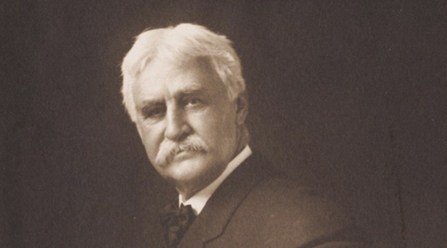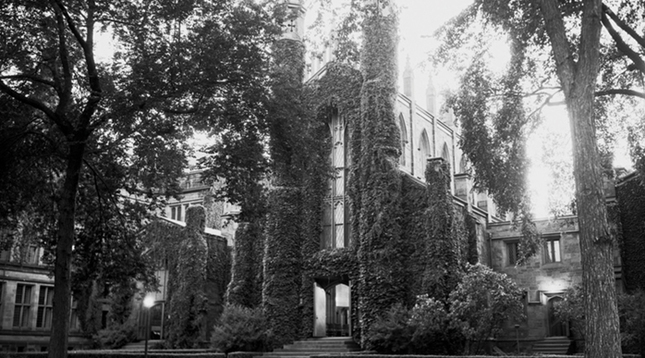
Beinecke Library
Yale trustee Joseph Twichell voiced his disapproval over students’ plans to plant a sprig of ivy plucked from the grave of Robert E. Lee.
View full image

Beinecke Library
Yale trustee Joseph Twichell voiced his disapproval over students’ plans to plant a sprig of ivy plucked from the grave of Robert E. Lee.
View full image

Manuscripts and Archives
Dwight Hall and other campus buildings were covered in ivy in the late nineteenth century.
View full image

Manuscripts and Archives
Dwight Hall and other campus buildings were covered in ivy in the late nineteenth century.
View full image
Nearly 160 years after the American Civil War ended, we’re still not done fighting it. How is the story of the war and its causes to be taught in schools? What should be done with Confederate monuments? These arguments are nearly as old as the war itself, and one of them flared up in 1896 over the planting of a shoot of ivy at Yale.
Since 1852, it had been a tradition that the graduating class of Yale College would plant a cutting of ivy on the Old Campus on Class Day. In 1896, the senior class announced that it would plant a specimen taken from the gravesite of Robert E. Lee, the commanding general of the Confederate army.
Yale was, of course, far north of the Mason-Dixon line, and the college itself had been squarely on the side of the Union during the war. But both before and after the war, Yale had educated a significant number of students from the South, and though most students and alumni had fought for the Union, some had fought for the Confederacy.
There was more than Yale’s own history in the air in 1896. In both the North and South, there was a growing attitude of reunion and reconciliation among white Americans, and a reframing of the war as a tragic, avoidable conflict in which both sides fought honorably to defend their homes. The graduating seniors who would plant the ivy had been born nearly a decade after the war. To these men, the time was ripe for letting bygones be bygones.
But on June 22, the day the ivy was to be planted, a Union veteran and influential alumnus would voice an objection. In the morning, before the Class Day ceremonies, Yale dedicated a statue of Theodore Dwight Woolsey ’20, the Yale president who had led the college through the Civil War years. The featured speaker was the Reverend Joseph Twichell ’59, a longtime Hartford pastor, Yale trustee, and close friend of Mark Twain. While still a seminarian, Twichell had been chaplain to an Irish American regiment in the Union army.
Twichell’s short speech, a straightforward tribute to Woolsey, included a passage about a conversation on the battle of Gettysburg that the two of them had had during the war. At that point, he departed from his prepared text, paused, and said that he thought Woolsey would be dismayed by the knowledge that “an ivy from the grave of Robert Lee, a good man but the historic representative of an infamous cause, shall be planted on this campus to climb the walls of ever loyal Yale.” Twichell then returned to his speech, but not before, as the Yale Alumni Weekly reported, “the older portion of the audience applauded vigorously and the Seniors kept still and looked a little glum.”
Twichell wrote in his journal that “I was just going to the platform to deliver [the address], when Dr. Newman Smyth told me that the graduating class were, that afternoon, to plant an ivy taken from the grave of Gen. R. E. Lee, the Confederate chief. I disliked the thing so much that I could not forbear an open protest against it. . . . The ivy was planted nevertheless, but I had the satisfaction of speaking my mind.”
The story was reported nationally in newspapers over the next few days. Some people applauded Twichell’s remarks. Smyth, pastor of New Haven’s Center Church and later a Yale trustee (and a veteran himself), said that he was “amazed when I read that the committee had selected this ivy” and that “Mr. Twichell voices the sentiment of all the older graduates.”
But many thought Twichell’s remarks were ill-advised, at best. Some Southern newspapers were especially vehement; the Birmingham News called Twichell “the reverend donkey” and said he had been “justly condemned for his narrow bigotry and sectional spirit.”
Meanwhile, some alums who were veterans of the war vowed to dig up the affronting ivy, while Southern seniors resolved to guard it day and night to prevent such an occurrence. By August, it was discovered that the ivy had been stolen. A second Lee cutting was planted quietly by the ’96 ivy committee just after commencement in 1897. Even if it survived the continued controversy, it is not likely that it still grows on Old Campus today. Once the damage ivy did to masonry was fully understood, most of the ivy that clung to the walls of Yale’s buildings was removed in the 1980s.
Yet the effort to smooth over memories of the war continued at Yale for decades. On the 50th anniversary of the war’s end, Yale built and dedicated a Civil War memorial that honored the Yale students and alumni who had died fighting: both those who had fought for the Union (114), and those who had fought for the Confederacy (54). They are not separated according to which side they served on but are listed in order of their graduation years. A poem set in the floor of the memorial—now illegible after a century of students’ footsteps—offers “Love and tears for the Blue / Tears and love for the Gray.”
 loading
loading